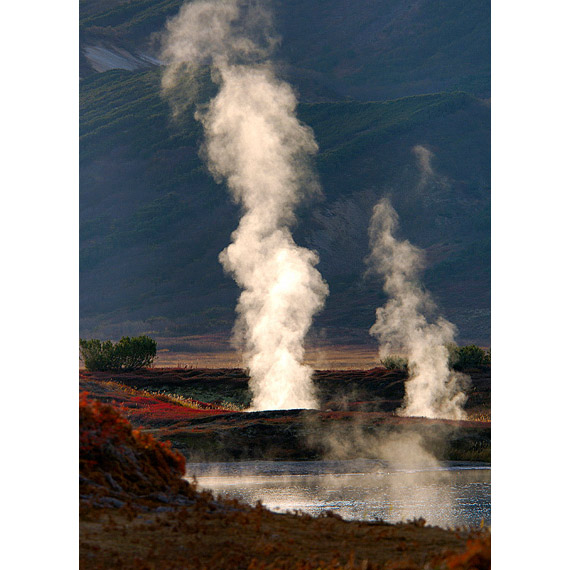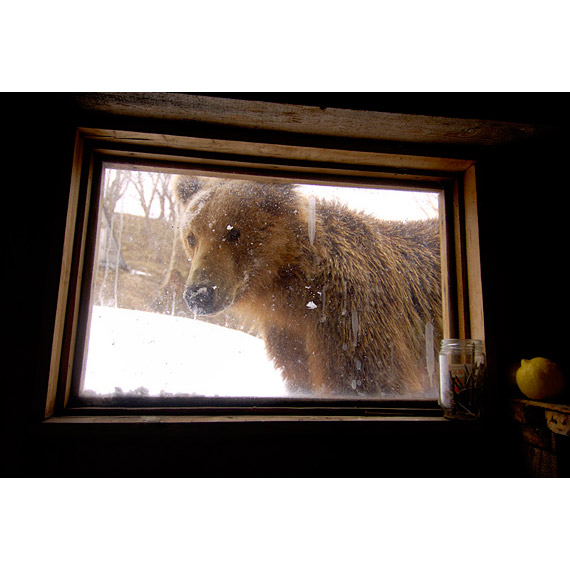Kamchatka: Russia’s Wild East
Kamchatka is like a time machine. When I arrived to the vast, unscathed wilderness six years ago, it felt as though I had traveled back 300 years. Wilderness still dominates the peninsula today as it did then. I was first drawn here by volcanoes, geysers and brown bears for a three-week photo expedition, but six years since this magical place still has not released its grip on me.
Kamchatka sits suspended between the Okhotsk Sea and the Pacific Ocean, on Russia’s easternmost border, where the sprawling Eurasian continent comes to an end and the mighty blue ocean begins. Here, fiery volcanoes reach skyward then slide down to dip their feet in the cold seas. Kamchatka’s volcanoes not only create spectacular scenery, they form unique mineral-rich ecosystems. Nutrient-laden streams support six species of spawning salmon. Here one can observe massive salmon runs in pristine watersheds still intact from ocean to stream or watch the Kamchatka brown bear – one of the largest in the world – as it fishes unabashed for salmon. Kamchatka’s Pacific coast teems with seabirds and marine mammals – cormorants, gulls, kittwakes, sea otters, seals and whales. Majestic Steller’s sea eagles and white-tailed sea-eagles soar overhead. Endemic snow sheep nimbly maneuver steep mountain cliffs while giant, wild reindeer graze the wide-open tundra beneath colossal volcanoes.
Kamchatka has been preserved primarily because of its remoteness from Russia’s industrial centers. A passenger jet requires nine hours to cover the more than 6,000 kilometers from Moscow to the peninsula’s capital of Petropavlovsk-Kamchatsky. If one were to draw a line the same distance on a map south from Moscow, one would end up in Johannesburg, South Africa. A line west would take one beyond New York City.
On Kamchatka, I retreated to the remote and strictly protected Kronotsky Nature Reserve, one of Russia’s 101 wilderness areas in a system of “zapovedniks” first established 95 years ago. Kronotsky was founded in 1934 to safeguard declining populations of Kamchatka’s valuable fur-bearing sable. My home – a small one-room ranger cabin in the heart of the preserve – was surrounded by the majesty of volcanoes, forests that never felt an axe and dramatic landscapes unscarred by power lines and roads. Wild animals I came across often had yet to learn that Man was the Czar of the taiga, as they refused to yield their age-old trails. Rivers were sometimes so thick with spawning salmon there was nowhere left to swim. Here I felt fully immersed in nature as it must have appeared to primeval man. This is a part of our past that we all pine for.

Igor Shpilenok|The azure blue waters filling the crater of Maly
Semyachik Volcano are rimmed with ice in June.
Krontosky Nature Reserve is more than one million hectares of remote wilderness. Nine of Kamchatka’s 29 active volcanoes puncture its crust. The Geyser River, with its famous Valley of the Geysers and hundreds of hot springs, runs through its midst. A vast volcanic plateau rises across the land, making some places so inaccessible that people haven’t set foot there for years. Vast glaciers nestle in mountain depressions and high waterfalls tumble into deep valleys. The enormous Kronotskoye Lake in the reserve’s center covers 242 square kilometers, the largest freshwater lake on Kamchatka. Kronotsky Nature Reserve is fronted by 250 kilometers of Pacific coast with precipitous cliffs and empty beaches of black volcanic sand in the Kronostky Bay. Whales spray fountains above the ocean waves while Steller’s sea lions and sea otters lounge on ice floes and rocks along the coast.
Kamchatka’s Valley of the Geysers, nestled in the narrow canyon of the Geyser River, was discovered only in 1941 by Tatiana Ustinova, a scientist at Kronotsky Nature Reserve. It is a wonder that the Valley of the Geysers happened to fall under protection of Kronotsky Nature Reserve, which was created seven years prior to its discovery. The Valley is a deep canyon that cuts for about 10 kilometers through the slopes of the Kikhpinych Volcano. The active part of the Valley is condensed in a six-kilometer stretch in the lower reaches of the Geyser River. Here, all known forms of hydrothermal phenomena are found: geysers, boiling permanent and pulsating hotsprings, small mud volcanoes, mud pots, thermal lakes, fumeroles and more. There were 41 significantly active geysers in the Valley before the mudslide of June 3, 2007 buried or flooded about one-half of them, including the first one discovered by Ustinova. Witnessing the transformation in the days following the mudslide, as a thermal lake formed where a mountain river once ran, I realized that the Valley, with its remaining geysers, became no less beautiful and remarkable. People who have never been there, upon seeing my photographs, accuse me of using Photoshop to tweak the colors. But in reality, the wide color palette of the Valley is formed by the multi-colored geyserites, volcanic clays and bright green heat-loving alga and microorganisms rimming the hot waterfalls and springs.

Igor Shpilenok|The landslide of June 3, 2007, blocked part of Kamchatka’s Valley of the Geysers, thus damning the Geyser River and creating a lake. This picture was taken on June 15, 2007, six days after the water breached the dam and formed a new channel, seen in the bottom right corner of the frame.
In the warm oasis of the Valley of the Geysers, spring arrives much earlier than on the surrounding volcanic plateau where snow lingers until the end of June, thus creating a unique ecosystem. Brown bears, upon emerging from their dens, congregate here to feed on young spring grasses. Birds, when spring is slow to arrive, feed on the abundance of insects on the thermal fields. Wagtails even construct their nests on the warm earth, which acts as a natural incubator and allows the birds to spend less time on the nest. Chicks grow more quickly in the warm nest and begin to fly earlier, thus increasing their chance of survival.
In May and June the surrounding mountains are still covered with snow. Only on the slopes of the canyon of the Geyser River, warmed by underground thermal processes, does an oasis of green grass grow, which attracts dozens of bears. This is also when the bears carry out their annual mating rituals. Overwhelmed by hormones, the bears, which don’t particularly fear humans in the nature reserve anyway, throw caution to the wind. They come right up to the cabin, and, thus, I had to remain wary.
The Valley of the Geysers is a crossroads of bear trails leading from denning areas to feeding grounds of berries and pine nuts and onto the fish-filled rivers near the ocean. In addition to the permanent residents of the Valley of the Geysers, transient bears often pass through. Some of them, having traveled from areas outside the reserve, would panic at the sight of humans. Others allowed people to observe them at a close distance because, having spent their lives in the safety of the reserve, they never had negative encounters with people. Bears quickly learned where it was safe to pass over a thermal field without getting burned and would often even use the boardwalks intended for tourists to walk through the Valley.
Kamchatka boasts the largest brown bears in Eurasia and the second largest in the world after the grizzlies on Kodiak Island in Alaska. Kamchatka also has some of the most fortunate bears in the world, not because of the extent of wilderness but because of the abundance of food. This region is unique because it boasts all three main types of foods that bears require to fatten up for the winter: berries, pine nuts and salmon. Six species of salmon alternate spawning periods and fill the rivers in turn from June through the winter to February. Kamchatka bears also have the added benefit of food scavenged along the seashore – seaweed, fish, mollusks, birds and marine mammals, including beached whales.

Igor Shpilenok|Shpilenok looks out his window from the ranger station one morning to
find a neighbor looking in from the Valley of the Geysers.
Despite its expanses of wilderness, the growing threats of poaching, overfishing, gold and platinum mining, and oil and gas exploration on the continental shelf could lead to the rapid demise of Russia’s final frontier. Poaching is probably the greatest threat to Kamchatka today, as it undermines its most valuable resource – salmon. Salmon is a keystone species on Kamchatka; take it away, and the entire ecosystem will collapse. Bears, eagles, seals, gulls and people all depend on salmon. Salmon is Kamchatka’s greatest renewable resource, which can provide income and food for generations. In the past decade, illegal fishing has proliferated under corrupt enforcement agencies and government institutions. In the ocean, fishing companies take two to three times more than the legal catch, thus decimating reproductive capacity of adult populations.
Oil exploration and prospective development of the continental shelf in the Okhotsk Sea in key feeding grounds for salmon, crabs and other sea life could lead to disruption of marine ecosystems and end in oil spills. An oil spill, such as that caused by the Exxon Valdez in Alaska or more recently in the Gulf of Mexico, could decimate entire populations of salmon and affect marine, freshwater and terrestrial ecosystems on western Kamchatka for decades.
Despite the growing threats, we still have an opportunity on Kamchatka to conserve some of the last true wilderness areas on our planet. About 14 percent of the peninsula is preserved in protected areas. True wilderness is not something that can be regenerated or replanted. Kamchatka is unlike any other place on the planet – a stronghold for biodiversity, an open-air laboratory for studying volcanic activity and formation of the earth. It is my hope that my photographs of this majestic and magical place will not someday be part of an historical archive demonstrating Kamchatka “before and after,” but, instead, will urge people to act now to preserve Kamchatka’s wildlands as they are for generations to come.
Igor Shpilenok’s Kamchatka Slideshow











































